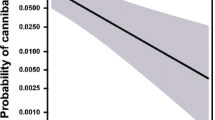Abstract
Female and male reproductive interests often differ. In species in which matings are accompanied by a transfer of resources valuable for both participants, such as nuptial prey gifts, conflicts may readily occur. Scorpionflies may use alternative mating tactics. One is to offer a prey item (dead arthropod) to females in exchange for mating. This prey gift tactic includes a conflict because a male must decide on whether to offer the gift rather than to fight the female and consume the gift. The outcome may depend on the nutritional status of both males and females. Males may be more willing to give if they themselves are satiated and the condition of the females may influence the payoff from the males’ investment. Similarly, females may be more willing to accept food gifts if they are in poor nutritional condition. In this study of the scorpionfly Panorpa cognata, I experimentally manipulated the feeding history of both males and females. I observed the outcome of the direct interactions that followed when males that were holding prey were approached by females. I found that well-fed males offered the food gift sooner than males in poor nutritional condition that fed extensively on the food item before offering. Female condition had no significant influence on whether prey items were offered by males or accepted by females. I also found that well-fed males rarely searched for prey to pursue the prey gift tactic in courtship. Thus, the prey tactic does not seem to be the males’ first option.

Similar content being viewed by others
References
Arnqvist G, Rowe L (2005) Sexual conflict. Princeton University Press, Princeton
Bockwinkel G, Sauer KP (1994) Resource dependence of male mating tactics in the scorpionfly, Panorpa vulgaris (Mecoptera, Panorpidae). Anim Behav 47:203–209
Bonduriansky R (2001) The evolution of male mate choice in insects: a synthesis of ideas and evidence. Biol Rev 76:305–339
Byers GW, Thornhill R (1983) Biology of the Mecoptera. Annu Rev Entomol 28:203–228
Chapman T, Arnqvist G, Bangham J, Rowe L (2003) Sexual conflict. Trends Ecol Evol 18:41–47
Cumming JM (1994) Sexual selection and the evolution of dance fly mating systems (Diptera: Empididae; Empidinae). Can Entomol 126:907–920
Dewsbury DA (1982) Ejaculate cost and male choice. Am Nat 119:601–610
Emlen ST, Oring LW (1977) Ecology, sexual selection, and the evolution of mating systems. Science 197:215–223
Engqvist L, Sauer KP (2001) Strategic male mating effort and cryptic male choice in a scorpionfly. Proc R Soc Lond B 268:729–735
Engqvist L, Sauer KP (2002a) Amorous scorpionflies: causes and consequences of the long pairing prelude of Panorpa cognata. Anim Behav 63:667–675
Engqvist L, Sauer KP (2002b) A life-history perspective on strategic mating effort in male scorpionflies. Behav Ecol 13:632–636
Engqvist L, Sauer KP (2003a) Determinants of sperm transfer in the scorpionfly Panorpa cognata: male variation, female condition and copulation duration. J Evol Biol 16:1196–1204
Engqvist L, Sauer KP (2003b) Influence of nutrition on courtship and mating in the scorpionfly Panorpa cognata (Mecoptera, Insecta). Ethology 109:911–928
Fox GA (1993) Failure-time analysis: Emergence, flowering, survivorship, and other waiting times. In: Scheiner SM, Gurevitch J (eds) Design and analysis of ecological experiments. Oxford University Press, Oxford, pp 253–289
Gross MR (1996) Alternative reproductive strategies and tactics: diversity within sexes. Trends Ecol Evol 11:92–98
Gwynne DT (1981) Sexual difference theory: mormon crickets show role reversal in mate choice. Science 213:779–780
Gwynne DT, Simmons LW (1990) Experimental reversal of courtship roles in an insect. Nature 346:172–174
Ihaka R, Gentleman R (1996) R: A language for data analysis and graphics. J Comput Graph Stat 5:299–314
Jönsson KI (1997) Capital and income breeding as alternative tactics of resource use in reproduction. Oikos 78:57–66
Roff DA (1992) The evolution of life histories: theory and analysis, 1st edn. Chapman and Hall, New York
Sauer KP (1970) Zur Monotopbindung einheimischer Arten der Gattung Panorpa (Mecoptera) nach Untersuchungen im Freiland und im Laboratorium. Zool Jahrb Syst 97:201–284
Sauer KP (1977) The adaptive significance of genetic variability of photoperiodic response in Panorpa vulgaris. Zool Jahrb Syst 104:489–538
Sauer KP, Sindern J, Kall N (1997) Nutritional status of males and sperm transfer in the scorpionfly Panorpa vulgaris (Mecoptera: Panorpidae). Entomol Gen 21:189–204
Sauer KP, Lubjuhn T, Sindern J, Kullmann H, Kurtz J, Epplen C, Epplen JT (1998) Mating system and sexual selection in the scorpionfly Panorpa vulgaris (Mecoptera: Panorpidae). Naturwissenschaften 85:219–228
Sauer KP, Epplen C, Over I, Lubjuhn T, Schmidt A, Gerken T, Epplen JT (1999) Molecular genetic analysis of remating frequencies and sperm competition in the scorpionfly Panorpa vulgaris (Imhoff and Labram). Behaviour 136:1107–1121
Sauer KP, Vermeulen A, Aumann N (2003) Temperature-dependent competition hierarchy: a mechanism stabilizing the phenological strategy in the scorpionfly Panorpa communis L. J Zool Syst Evol Res 41:109–117
Simmons LW (1992) Quantification of role reversal in relative parental investment in a bush cricket. Nature 358:61–63
Stearns SC (1992) The evolution of life histories. Oxford University Press, Oxford
Stockley P (1997) Sexual conflict resulting from adaptations to sperm competition. Trends Ecol Evol 12:154–159
Therneau TM, Grambsch PM (2000) Modeling survival data: extending the Cox model, 3rd edn. Springer, Berlin Heidelberg New York
Thornhill R (1980a) Competition and coexistence among Panorpa scorpionflies (Mecoptera: Panorpidae). Ecol Monogr 50:179–197
Thornhill R (1980b) Rape in Panorpa scorpionflies and a general rape hypothesis. Anim Behav 28:52–59
Thornhill R (1981) Panorpa (Mecoptera: Panorpidae) scorpionflies: systems for understanding resource-defense polygyny and alternative male reproductive efforts. Ann Rev Ecolog Syst 12:355–386
Thornhill R (1983) Cryptic female choice and its implications in the scorpionfly Harpobittacus nigriceps. Am Nat 122:765–788
Thornhill R (1987) The relative importance of intra- and interspecific competition in scorpionfly mating systems. Am Nat 130:711–729
Thornhill R, Alcock J (1983) The evolution of insect mating systems. Harvard University Press, Cambridge, Massachusetts
Thornhill R, Sauer KP (1991) The notal organ of the scorpionfly (Panorpa vulgaris): an adaptation to coerce mating duration. Behav Ecol 2:156–164
Thornhill R, Sauer KP (1992) Genetic sire effects on the fighting ability of sons and daughters and mating success of sons in a scorpionfly. Anim Behav 43:255–264
Venables WN, Ripley BD (2002) Modern applied statistics with S, 4th edn. Springer, Berlin Heidelberg New York
Acknowledgements
I thank Klaus Peter Sauer, Tim Schmoll, Jo Frommen and three anonymous referees for the valuable comments on the manuscript, the Deutsche Forschungsgemeinschaft for the financial support [LE 469/1-1] and Julia Leven, Christiane Fritsche and Kim Schmidt for the laboratory help. The experiments in this study comply with the current laws on animal use in Germany.
Author information
Authors and Affiliations
Corresponding author
Additional information
Communicated by D. Gwynne
Rights and permissions
About this article
Cite this article
Engqvist, L. Sex, food and conflicts: nutrition dependent nuptial feeding and pre-mating struggles in scorpionflies. Behav Ecol Sociobiol 61, 703–710 (2007). https://doi.org/10.1007/s00265-006-0300-3
Received:
Revised:
Accepted:
Published:
Issue Date:
DOI: https://doi.org/10.1007/s00265-006-0300-3




